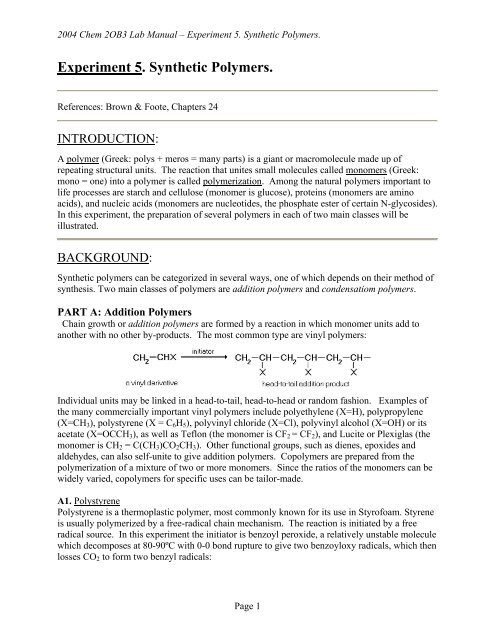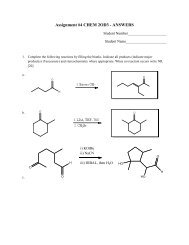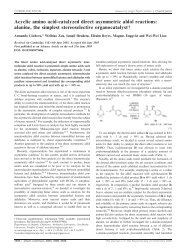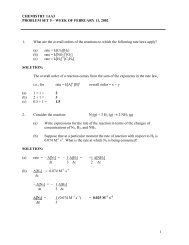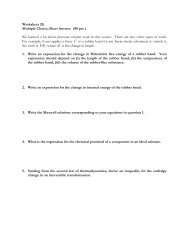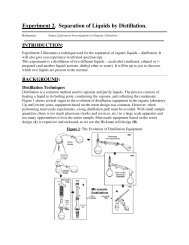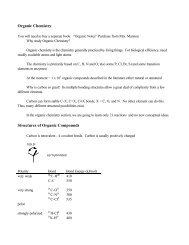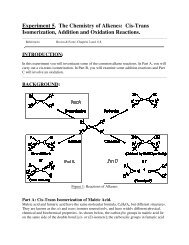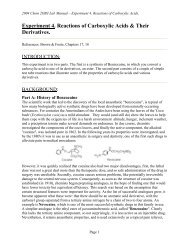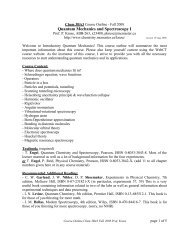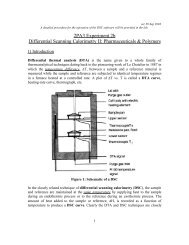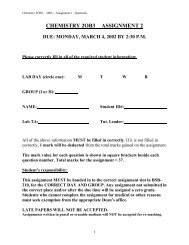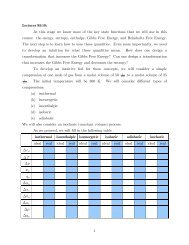Expt.5
Expt.5
Expt.5
- No tags were found...
You also want an ePaper? Increase the reach of your titles
YUMPU automatically turns print PDFs into web optimized ePapers that Google loves.
2004 Chem 2OB3 Lab Manual – Experiment 5. Synthetic Polymers.Experiment 5. Synthetic Polymers.References: Brown & Foote, Chapters 24INTRODUCTION:A polymer (Greek: polys + meros = many parts) is a giant or macromolecule made up ofrepeating structural units. The reaction that unites small molecules called monomers (Greek:mono = one) into a polymer is called polymerization. Among the natural polymers important tolife processes are starch and cellulose (monomer is glucose), proteins (monomers are aminoacids), and nucleic acids (monomers are nucleotides, the phosphate ester of certain N-glycosides).In this experiment, the preparation of several polymers in each of two main classes will beillustrated.BACKGROUND:Synthetic polymers can be categorized in several ways, one of which depends on their method ofsynthesis. Two main classes of polymers are addition polymers and condensatiom polymers.PART A: Addition PolymersChain growth or addition polymers are formed by a reaction in which monomer units add toanother with no other by-products. The most common type are vinyl polymers:Individual units may be linked in a head-to-tail, head-to-head or random fashion. Examples ofthe many commercially important vinyl polymers include polyethylene (X=H), polypropylene(X=CH 3 ), polystyrene (X = C 6 H 5 ), polyvinyl chloride (X=Cl), polyvinyl alcohol (X=OH) or itsacetate (X=OCCH 3 ), as well as Teflon (the monomer is CF 2 = CF 2 ), and Lucite or Plexiglas (themonomer is CH 2 = C(CH 3 )CO 2 CH 3 ). Other functional groups, such as dienes, epoxides andaldehydes, can also self-unite to give addition polymers. Copolymers are prepared from thepolymerization of a mixture of two or more monomers. Since the ratios of the monomers can bewidely varied, copolymers for specific uses can be tailor-made.A1. PolystyrenePolystyrene is a thermoplastic polymer, most commonly known for its use in Styrofoam. Styreneis usually polymerized by a free-radical chain mechanism. The reaction is initiated by a freeradical source. In this experiment the initiator is benzoyl peroxide, a relatively unstable moleculewhich decomposes at 80-90ºC with 0-0 bond rupture to give two benzoyloxy radicals, which thenlosses CO 2 to form two benzyl radicals:Page 1
2004 Chem 2OB3 Lab Manual – Experiment 5. Synthetic Polymers.PART B: Condensation PolymersStep Growth or Condensation polymers are formed by reaction between molecules with two ormore functional groups (such as glycols, diamines, and dicarboxylic acids), with each new bondcreated in a separate step. This method gives long chains joined by many ester or amide linksalong with the elimination of some small molecule such as water, ammonia, or hydrogenchloride. Examples include Nylon (a polyamide), Dacron (a polyester), Bakelite, andpolyurethane foams.B1. BakeliteBakelite is the oldest totally synthetic polymer invented by Leo Baekeland in 1907. Phenol andformaldehyde react, in the presence of acid or base, to form a three-dimensional polymer --Bakelite -- suitable for making many molded articles. The reaction sequence for the acidcatalyzed reaction is:Under carefully controlled conditions, o- or p-hydroxybenzyl alcohol may actually be isolate.The next step involves protonation of the alcohol, formation of a benzyl cation, and anelectrophilic aromatic substitution:In this manner, phenol molecules become linked to one another at ortho or para positions bymethylene groups;Page 3
2004 Chem 2OB3 Lab Manual – Experiment 5. Synthetic Polymers.B2. Nylon 6-6Under appropriate conditions a variety of dicarboxylic acids will react with diamines to givepolyamides and water. These polymers can hydrogen-bond with each other to give strong fibres.PRE-LAB PREPARATION:1. Draw the structure of benzoyl peroxide and show how benzoyl peroxide decomposes to formtwo radicals (use curly arrows, etc.).2. Two different radicals could be produced when an initiator radical adds to styrene.Show the structures of two radicals. Which one is preferred, and why?3. Draw the structure of poly(methyl methacrylate).4. Draw the structures of 1,6-hexanediamine, adipoyl chloride and nylon 6-6.EXPERIMENTAL PROCEDURE:PART A: Addition PolymersA1. Polystyrenea) In a fume hood, to 4.55g (5 mL) of styrene in a medium sized test tube, 0.2g benzoylperoxide. [Care: do not CRUSH this solid].b) Write your name on a little (9mm x 20mm) piece of paper and put it into the test tube.c) Place the test tube in a beaker of boiling water (on a hotplate) for over 1 hour.d) Cool the tube, and examine the polymer. You may have to break the test tube, but first wrap itin a paper towel (have your TA show you how this is done). Be careful with the broken glass.e) Describe the polymer (colour, clear/opaque, stiff/flexible, brittle, solid/pellets/powder, etc.).A2. Methyl Methacrylate Polymera) In a fume hood, to 5 mL of freshly distilled methyl methacrylate in a medium test tube, add 1drop of N,N-dimethylaniline and 0.08g of benzoyl peroxide.b) Write your name on a little (9mm x 20mm) piece of paper and put it into the test tube.c) Place the test tube in a beaker of boiling water (on a hotplate) for about 1 hour.d) Cool the tube, and describe the polymer. You may have to break the test tube, but first wrap itin a paper towel (have your TA show you how this is done). Be careful with the broken glass.e) Describe the polymer (colour, clear/opaque, stiff/flexible, brittle, solid/pellets/powder, etc.).PART B: Condensation PolymersB1. Bakelitea) In a fume hood, place 1.2 g of phenol, 3.5 mL of glacial acetic acid, and 1.5 mL of 37-40%aqueous formaldehyde solution in a test tube.b) Warm the tube slightly, with shaking, to melt the phenol and obtain a homogeneous solution.c) Cool the test tube in an icebath and then place the test tube in the fumehood. Add 3.5 mL ofconc. HCl to the test tube while still in the fumehood. Shake until you see the solid polymerstarting to form and set aside to finish.d) Cool the tube, then dislodge and examine the polymer.e) Describe the polymer (colour, clear/opaque, stiff/flexible, brittle, solid/pellets/powder, etc.).Page 4
2004 Chem 2OB3 Lab Manual – Experiment 5. Synthetic Polymers.B2. Nylon 6-6NOTE: For this polymer, measure everything directly into your beaker. Don’t use yourgraduated cylinder, as the polymer will form in your graduated cylinder and is difficult toremove. Use the graduation on your beaker.a) Pour approx. 10 mL of 5% aqueous solution of 1,6-hexanediamine into a 100 mL beaker. Add20 drops of 10% sodium hydroxide solution.b) Tilt the beaker slightly, and carefully pour down the wall approx. 10 mL of a 5% solution ofadipoyl chloride in hexane, trying to avoid mixing or turbulence.c) A polymer film will form at the interface. Grasp this with a piece of hooked metal or pair oftongs. Fasten it to a large test tube or narrow beaker, and slowly rotate it, to draw out a polymerfibre.d) Finally, rinse your fibre with water and dry on a piece of paper towel.e) Describe the polymer (colour, clear/opaque, stiff/flexible, brittle, solid/pellets/powder, etc.).f) Obtain and label an IR spectrum of your polymer.g) Once you have made all four polymers, show them to your TA.Page 5


